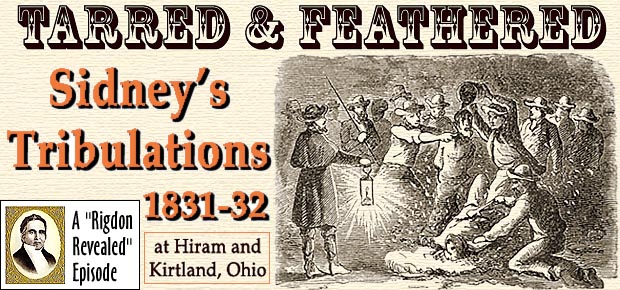
FEATURE ARTICLES

Elder Sidney Rigdon's ‘Hiram Period’
Early Historical Sources | Recent Historical Sources | Ryder Family and Campbellites at Hiram
This Web-page is still under construction:
|
March 24, 1832 - Hiram, Ohio On April 5, 1832 the Hudson Ohio Observer and Telegraph published the following shocking report, communicated to the editor from neighboring Hiram:"...on Saturday night, March 24th, a number of persons, some say 25 or 30, disguised with colored faces, entered the rooms in Hiram, where the two Mormonite leaders, Smith and Rigdon were sleeping, and took them, together with the pillows on which they slept, carried them a short distance and after besmearing their bodies with tar, applied the contents of the pillows to the same."Both Mormon leaders survived the attack; and by the time most Ohioans would have heard the news, Elders Smith and Rigdon were already well on their way to a Missouri getaway. Since 1832 multiple commentators have ascribed the 1832 tar and feathering to various motives on the part of the anonymous attackers. Although Mormon leaders never made any formal charges, a hint as to the assailants' identities was dropped by Joseph Smith himself, in the 1839 writing of his manuscript personal history. As published in the Nauvoo Times and Seasons of Aug. 15, 1844, the relevant information supplied by Smith (the only known communicative eye witness) reads thusly: I would remark that nothing important had occurred since I came to reside at father Johnson's house in Hiram; I had held meetings on the sabbaths and evenings and baptized a number. Father Johnsons Son, Olmsted Johnson, about this time [March, 1832] came home on a visit, during which I told him if he did not obey the gospel, the spirit he was of would lead him to destruction, and when he went away, he would never return or see his father again.... In addition to the apostate Ezra Booth, Symonds Rider, Eli Johnson, Edward Johnson and John Johnson jr. had apostatized.... In the above excerpt from Smith's own account, the impression is clearly implanted in the reader's mind, that two of Smith's host's sons (Olmsted and John) had left the Mormon fellowship, possessed by a bad spirit, and that two more family members (Eli and Edward Johnson) had also also fallen into apostasy, along with the vocal critics, Ezra Booth and Simonds Ryder. The relationship of Eli and Edward to the rest of the Johnsons named by Smith is left ambigious, but the hasty reader might be forgiven if he came away from reading Smith's account, thinking that Simonds Ryder had that cold March night led an attack by "a mob" of about "a dozen men," including Eli Johnson and perhaps some other Johnsons. It is important, also, that the reader recall that Father Johnson and most of his family had by that time (1839) left the LDS Church and the former friendship of Joseph Smith, jr. Without ever making the precise accusation, Smith manages to convey the impression that some Johnsons were in some way responsible for his 1832 injuries and fears of continued persecution. |
|
Sources Consulted:
|
OPENING NEW HORIZONS IN MORMON HISTORY